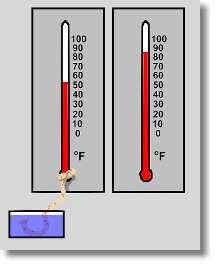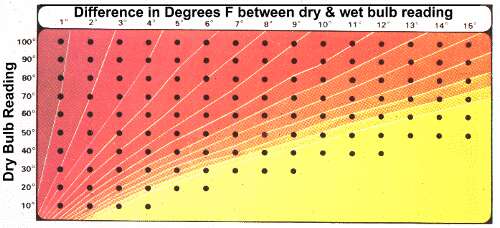|
A hygrometer is a device used to measure the humidity of the air. Here is a simple design for a wet/dry hygrometer. You will need two inexpensive thermometers, a shoelace, a small bowl of water, and the accompanying chart, which can be saved and printed. This design and the chart are from the Time Life Science series, in the volume entitled 'Weather'.  The two thermometers are attached to a board, and a wet shoelace is tied to the bottom of one thermometer. The other end of the shoelace is kept immersed in a bowl of water. That's all there is! The principle that makes this hygrometer work is that water will evaporate from the wet shoelace, cooling the thermometer to which it is attached. (Evaporation uses heat). This will make the left 'wet' thermometer record a lower temperature than the right 'dry' one. If the air is dry, a lot of water will evaporate from the shoelace, making the temperature of that thermometer drop considerably. If the air is very humid, little evaporation will occur, and the temperature drop will be minimal. In order to measure the '% humidity' in the air, you must calibrate the device. One way to do this would be to measure the difference in temperatures between the two thermometers and record the humidity at that moment using a pre-calibrated device. But a quicker way is to use a set of 'wet/dry' humidity tables. We've provided one here. You may have noticed that our thermometers above show temperature in degrees Fahrenheit. That's because we could only find a chart that measured humidity using that temperature scale:  If you can find a chart using Celsius degrees, then your thermometers can be Celsius too! To use the chart: Find the temperature of the 'dry' thermometer on the left. Then across the top, find the difference in temperatures between the two thermometers that you recorded. Find the dot on the chart where these two readings meet. Notice that the chart is divided up into coloured bands. If your dot is in the first band (reading from the left), the humidity is 95% or more. Every band to the right is 5% less, down to about 30%. |